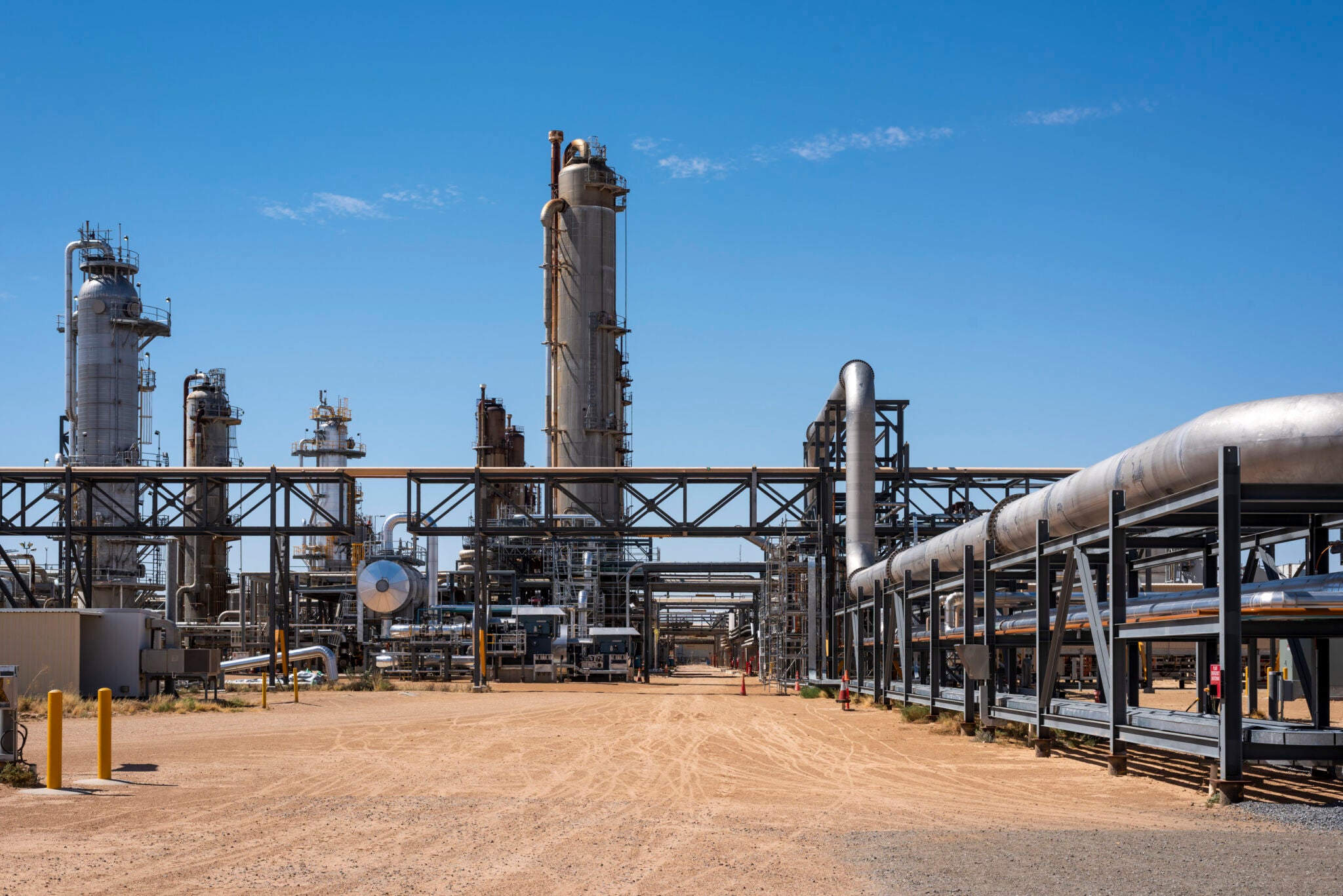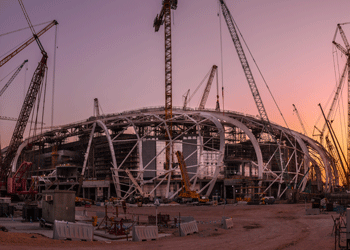Saudi Arabia under project pressure
28 March 2023

Saudi Arabia’s projects market is overheating. The volume of projects announced in the past six years vastly exceeds the resources that are available to work in the kingdom.
Combined with tight deadlines to complete projects as part of Vision 2030, the pressure on the construction industry to deliver is ratcheting up and turning the tables on the supply chain as the shift from a buyer’s to a seller’s market accelerates.
For the five years from 2016 to 2020, there was an average of about $14bn-worth of contract awards a year in Saudi Arabia for the construction and transport sectors. After rising to $21bn in 2021, the total rose to $32bn in 2022 – the second-best year on record.
The near doubling of the total annual value of contract awards by the end of 2022 has required a significant scale-up of resources in the kingdom, and the ramp-up is set to continue.
Much of this pressure is due to the five official gigaprojects, which are major programmes of work that will involve a sustained flow of contract awards for years to come.
Gigaproject focus
The project most recently classified as a gigaproject by the Saudi authorities is the Diriyah Gate development on the western outskirts of Riyadh. It joins the $500bn Neom development in the northwest of the kingdom, Qiddiya entertainment city outside Riyadh, Red Sea Global’s projects on the Red Sea coast and Roshn’s housing developments across the kingdom.
These projects are relatively new. They began to be launched in 2017 and spent much of the following three years in the design phase.
After a start that was hampered by the work and travel restrictions required to manage the Covid-19 pandemic, construction activity on these projects has accelerated sharply since the start of 2022.
According to regional project tracker MEED Projects, there have been $36bn-worth of contract awards across these official gigaprojects since 2017. Compared to the entire Saudi projects market over the same period that represents 14.5 per cent of contract awards.
The percentage rises to 20 per cent if a more recent time frame is used and only contract awards since the start of 2022 are included. As work gathers pace on the gigaprojects, their significance is expected to grow even further.
 More major projects
More major projects
Saudi Arabia’s ambitions are not limited to the five gigaprojects. In January, Crown Prince Mohammed bin Salman al-Saud launched the world’s largest modern downtown in Riyadh.
Known as the New Murabba project, it involves the development of 19 square kilometres of land to the northwest of the capital. The centrepiece of the project is the Mukaab, which is a 400-metre-cubed structure with a tower standing inside it.
New Murabba is part of a plan announced in January 2021 to double the size of Riyadh from 7.5 million residents to 15-20 million residents in 2030. Other major projects in the capital include King Salman International airport, King Salman Park, Sports Boulevard and Mohammed bin Salman Non-Profit City.
Beyond the capital there are development projects planned in all major urban centres by Saudi Downtown Company, as well as entertainment centres being developed by Saudi Entertainment Ventures (Seven).
Connecting these cities and projects will be railways, roads, ports and airports that form part of the National Transport & Logistics strategy, which aims to turn the kingdom into a global hub for travel and trade by 2030.
 World’s largest piling project shifts to The Line’s marina
World’s largest piling project shifts to The Line’s marina
Resourcing challenges
One of the key challenges for the development firms and government agencies responsible for delivering these projects is securing the resources they need.
As client bodies attempt to make their projects more attractive for companies to work on, the industry is changing. The first signs of this change can be seen in the consultancy market.
After years of searching for project opportunities, the big consultancy businesses are now only selectively bidding for projects in the kingdom. This is because their orderbooks are already full, and for many international firms there is a concern that they could become over-exposed to the Saudi market.
On contracts that have already been won there are also challenges. Staffing projects is proving difficult as the kingdom remains a hard sell for many project professionals, despite significant social reforms that have taken place in recent years.
Then, once staff have been recruited and deployed on projects, there is the prospect of losing them to competitors or clients that require the same human resources.
Securing contractors
As activity on site accelerates, the bigger concern is contracting resources. As things stand, there are not enough contractors working in Saudi Arabia to deliver all of the planned projects.
The first way to deal with this problem is to increase the capacity of contractors in the kingdom. In February this year, the Public Investment Fund (PIF) invested $1.3bn in four local construction firms: Al-Bawani Holding Company, Almabani General Contractors Company, El-Seif Engineering Contracting Company and Nesma & Partners Contracting Company.
This investment will allow the companies to scale up their capacity, adopt advanced technologies and improve local supply chains.
As these firms grow, the hope is that it will encourage other local companies to also expand.
International or regional companies can also help, and over the past two years foreign players have become active in the kingdom again. Firms such as Bouygues, Samsung C&T, Hyundai Engineering Construction, China State, Webuild, FCC, Alec, Consolidated Contractors Company and Urbacon Trading Contracting Company have all secured major orders.
In some cases, these contract awards have been supported with foreign finance, which gives the contractor an additional level of comfort when it comes to potential payment for projects. For others, the contract awards reflect growing assurance in the Saudi market.
Boosting appeal
Confidence has been lifted by measures to make the Saudi market more attractive. Payment terms are improving and many of the frustrations typically faced by contractors are being addressed.
One example is the use of performance guarantees. Red Sea Global, which is developing the Red Sea Project and Amaala gigaprojects on the Red Sea coast, no longer requires contractors to submit bid bonds and returns performance bonds on completion of the project, along with half of the retention.
Alternative procurement methods and contract types are also being used, notably early contractor involvement and design and build.
These different approaches reduce risk for the contractor and allow the client to lock in resources at a much earlier stage of the procurement process.
Red Sea Global has adopted a different approach and is self-delivering the bulk of its projects. By acting as its own management contractor, it engages with subcontractors itself. While this means it does not need to secure the services of a main contractor, it still requires engaging with the supply chain, which – like the main contractor market – has finite resources in Saudi Arabia.
Payment terms are improving and many of the frustrations typically faced by contractors are being addressed
Driving efficiency
On the other side of the equation, making construction more efficient could also help to limit the resources required.
Client bodies are exploring modern methods of construction to increase the speed of delivery, reduce costs and cut the amount of resources needed on site.
The market could also be self-limiting. Decision-making in the kingdom remains centralised, which means key project decisions can be slow. While this is changing as development companies are left to run their own projects, bureaucracy can impact the speed of delivery, which ultimately reduces the immediate demand for resources on a project.
While slow decision-making could impact progress on some projects, the overriding story for 2023 will be one of sustained pressure on the kingdom’s construction sector as it becomes a seller’s market.
With that, there is the likelihood that contractor margins will start to creep up, just as they did in the UAE when its construction market overheated in 2003 and 2008.
So far, that does not appear to have happened, as clients in Saudi Arabia have managed to find sufficient resources. For that to remain the case will be a major challenge, however, as on-site activity for most projects in the kingdom is still several years away from peaking.
|
International contractors continue to see a level of risk in the Saudi market “There is a lot of opportunity. A large volume of work is being planned, designed and rolled out. With that, there is significant pressure right now on the market in terms of resources and supply chain. “On the consultancy side, the market is tremendously difficult. “Even with the best incentives and best set of practices, retaining staff is a challenge. People are being attracted elsewhere and the competition is fierce. “For the contractors, there are a lot of tenders being let. The perception that the market has risk remains, however. That is certainly the perception for international contractors, and they are still looking at the Saudi market with some level of risk appreciation in terms of how quickly they are going to be paid and what the margins really are. “That approach will likely prevail for the short to medium term, until clients’ practices change in terms of contractual frameworks and payment practices. “Varied procurement practices are coming into play to guarantee supply chain. It might be early contractor involvement or partnering, but the main purpose is to guarantee the right level of contractors.” |
|
To prevent resource shortages, supply chain and procurement must be carefully considered “It is imperative to consider alternative methods of procurement during boom times, and the current boom in Saudi Arabia is unprecedented considering the types, size, nature and complexity of projects that have been announced in line with Vision 2030. “This necessitates giving due consideration to the supply chain and type of procurement. “It is not enough to look for resources locally or even regionally to cope with such projects. One needs to reach out to where such resources are available globally, either due to slowdowns in certain regions or the completion of other major projects. “Cost-plus contracts were used previously in many projects in Saudi Arabia. However, the risk for such contracts rests with the client and sometimes the cost ends up much more than expected. That is why financiers prefer the lump-sum type of contracts. “Nonetheless, I can see this type of contract being used for fast-track projects with very tight schedules, for instance to meet deadlines for facilities required for international or regional sporting events. “In any case, the evaluation and selection of contractors needs to be done with extreme diligence.” |
MEED's April 2023 special report on Saudi Arabia includes:
> ECONOMY: Riyadh steps up the Vision 2030 tempo
> CONSTRUCTION: Saudi construction project ramp-up accelerates
> UPSTREAM: Aramco slated to escalate upstream spending
> DOWNSTREAM: Petchems ambitions define Saudi downstream
> POWER: Saudi Arabia reinvigorates power sector
> WATER: Saudi water begins next growth phase
> BANKING: Saudi banks bid to keep ahead of the pack
Exclusive from Meed
-
 Contractors prepare bids for Aramco gas compression project
Contractors prepare bids for Aramco gas compression project13 November 2025
-
 Aramco Stadium races towards completion
Aramco Stadium races towards completion12 November 2025
-
 Oman signs PPA for 125MW Dhofar 2 wind project
Oman signs PPA for 125MW Dhofar 2 wind project12 November 2025
-
 Hitachi wins Alexandria Raml tram systems deal
Hitachi wins Alexandria Raml tram systems deal12 November 2025
-
 Contract award nears for Al-Ula tram works
Contract award nears for Al-Ula tram works12 November 2025
All of this is only 1% of what MEED.com has to offer
Subscribe now and unlock all the 153,671 articles on MEED.com
- All the latest news, data, and market intelligence across MENA at your fingerprints
- First-hand updates and inside information on projects, clients and competitors that matter to you
- 20 years' archive of information, data, and news for you to access at your convenience
- Strategize to succeed and minimise risks with timely analysis of current and future market trends

Related Articles
-
 Contractors prepare bids for Aramco gas compression project
Contractors prepare bids for Aramco gas compression project13 November 2025

Register for MEED’s 14-day trial access
Saudi Aramco is making progress with the main contract tendering process for a project to boost gas compression capacity at the Shedgum and Uthmaniya processing plants in the kingdom’s Eastern Province.
The Shedgum and Uthmaniya plants currently receive approximately 870 million cubic feet a day (cf/d) and 1.2 billion cf/d of Khuff raw gas, respectively.
Through this multibillion-dollar project, Aramco aims to increase the compression and processing capacity of the two plants, as well as to construct new pipelines to enhance gas transport.
Contractors are preparing bids for several engineering, procurement and construction (EPC) packages of the Shedgum and Uthmaniya gas compression capacity expansion project. Aramco has set a bid submission deadline of 17 November, according to sources.
The Saudi energy giant is understood to have started the solicitation of interest process for the main EPC contract tendering exercise in the fourth quarter of last year.
Aramco then issued the tenders for the EPC packages of the scheme during the second quarter of this year and set an initial bid submission deadline of 17 August, the sources said.
In line with its aim of increasing gas production and processing capacity by 60% by 2030, with 2021 as its baseline, Aramco is investing significant capital in gas projects in the kingdom this year.
Aramco’s capital expenditure (capex) in the third quarter of 2025 stood at $12.55bn, a marginal year-on-year increase of 2%. For the first nine months of the year, the firm registered capex of $37.41bn, an increase of 3.38% compared to the same period last year.
The company previously announced capital investment guidance in the range of $52bn-$58bn for 2025, excluding around $4bn of project financing.
ALSO READ: Aramco turns attention to strategic projects
 READ THE NOVEMBER 2025 MEED BUSINESS REVIEW – click here to view PDF
READ THE NOVEMBER 2025 MEED BUSINESS REVIEW – click here to view PDFMena players up the ante in global LNG production race; Investment takes UAE non-oil economy from strength to strength; Project finance activity draws international lenders back to market
Distributed to senior decision-makers in the region and around the world, the November 2025 edition of MEED Business Review includes:
> AGENDA 1: Gulf LNG sector enters a new prolific phase> INDUSTRY REPORT 1: Region sees evolving project finance demand> INDUSTRY REPORT 2: Iraq leads non-GCC project finance activity> GREEN STEEL: Abu Dhabi takes the lead in green steel transition> DIGITISATION: Riyadh-based organisation drives digital growth> UAE MARKET FOCUS: Investment shapes UAE growth storyTo see previous issues of MEED Business Review, please click herehttps://image.digitalinsightresearch.in/uploads/NewsArticle/15075053/main4642.jpg -
 Aramco Stadium races towards completion
Aramco Stadium races towards completion12 November 2025

Register for MEED’s 14-day trial access
The Aramco Stadium in Khobar is moving forward at an impressive pace as the fast-track project races towards completion in 2026.
The 47,000-seat stadium will be the new home for the Aramco-owned Al-Qadsiah Club and a key venue for the 2027 AFC Asian Cup and the 2034 Fifa World Cup.
The project’s progress stems from detailed planning and an accelerated delivery strategy. The project was conceived in May 2023, with the design process, managed by Aramco, commencing shortly thereafter.
“We completed the design within six months,” said Mohammed Subhi, the Aramco Stadium’s project manager.

The project advanced quickly due to thorough planning and a fast-track delivery approach. Initiated in May 2023, the design phase—overseen by Aramco—was completed within six months
An early engagement approach with the main contractor – a joint venture of Besix and Al-Bawani – was instrumental in maintaining momentum. This partnership began early in 2024, allowing for collaborative input on critical construction elements.
This upfront collaboration minimised pre-construction time, ensuring a rapid transition to site work.
Engineering challenges
 The stadium’s architectural design, inspired by the natural whirlpools of the Gulf and featuring interwoven transparent sails, presents significant engineering challenges, particularly in the structural steel and façade work. For spectator comfort, the stadium is equipped with full cooling systems and designed to the highest international standards.
The stadium’s architectural design, inspired by the natural whirlpools of the Gulf and featuring interwoven transparent sails, presents significant engineering challenges, particularly in the structural steel and façade work. For spectator comfort, the stadium is equipped with full cooling systems and designed to the highest international standards.Logistics management is another crucial facet of the project, which is located in central Khobar. With thousands of workers on site, the movement of materials is tightly controlled to minimise community disruption.
“We control how many trucks can enter the site and at what time. For example, we cannot cast concrete during the day. It has to be after 6pm, up until the early morning,” said Subhi.
A key priority on site is health and safety, an area where the organisation’s legacy from its oil and gas operations is clearly visible. Subhi explains that the principle of health and safety is part of the company’s DNA and is embodied in the deployment of advanced technology and rigorous standards, which have collectively resulted in over 10 million safe working hours to date.
The project employs a sophisticated Smart Safety Command Centre (SCC), which utilises artificial intelligence-based monitoring and 24/7 surveillance. One key feature of the centre is the crane collision prevention system – a key technological advancement in heavy machinery coordination and a first for the region.
“We have tower cranes and crawler cranes talking to each other. The anti-collision system means cranes talk to each other without human interference, and they automatically shut down when they are too close to each other,” said Subhi.

A key technological advancement is the crane collision prevention system, which means the cranes talk to each other and shut down if they become too close
In addition to ground operations, the project is leveraging aerial technology to mitigate risk in high-altitude work.
“We have used drones for the inspection of the cranes and inspection of the steel structure itself to minimise the risk of working at height,” said Subhi.

Drones have been adopted on-site to mitigate the risk of working at height
Worker welfare
The project’s commitment extends beyond mere regulatory compliance to comprehensive worker welfare, establishing a high standard for construction sites in the region.
With current staffing reaching approximately 11,000 direct and indirect workers, welfare provisions are a core priority, linking directly back to Aramco’s corporate standards.
In a region where extreme heat is a constant challenge, the project has implemented advanced heat stress management protocols. This includes the installation of heat sensors with alarm systems, mandatory work stoppage during peak heat hours and regular briefings on heat exhaustion symptoms. Fully air-conditioned rest areas are provided for breaks and meals.
Aramco is also committed to developing national talent. A significant proportion of the staff are young, and about 20% of the team are women.
The relationship with the joint-venture contractor is defined by collaboration rather than traditional client-contractor hierarchy. “We are one team, working together,” said Subhi. This approach has fostered a cooperative environment that is accelerating the on-site progress towards the 2026 completion goal.
https://image.digitalinsightresearch.in/uploads/NewsArticle/15073939/main.gif -
 Oman signs PPA for 125MW Dhofar 2 wind project
Oman signs PPA for 125MW Dhofar 2 wind project12 November 2025
Singapore's Sembcorp Utilities and local firm OQ Alternative Energy (OQAE) have won a contract to develop the 125MW Dhofar 2 wind independent power project in Oman.
The contract was awarded by state offtaker Nama Power & Water Procurement Company (Nama PWP) under a 20-year power purchase agreement (PPA).
Under the PPA, Sembcorp and OQAE will form a joint venture to build, own and operate the wind farm, which will supply power to Nama PWP once operational.
The equity split will give Sembcorp 75% and OQAE 25%, a source close to the project told MEED.
Nama PWP said that it will allocate a portion of contracted works for the Dhofar 2 project to Omani small and medium-sized enterprises under its in-country value programme.
The project is expected to begin commercial operations in the third quarter of 2027.
The facility, valued at about OR43m ($112m), will be located on a 12-square-kilometre site in Dhofar Governorate.
The project comprises 20 Windey WD200 turbines, each with a 6.25MW capacity. Each turbine stands 215 metres tall and will be connected to the national grid via a 400kV substation.
The development will provide clean electricity to more than 18,000 homes and will cut carbon dioxide emissions by about 158,000 tonnes a year.
It is also expected to generate about 396,754 megawatt-hours and free up around 76 million cubic metres of natural gas annually.
Sembcorp has over 1.1GW of energy assets in Oman. In September, the firm signed a new 10-year power and water purchase agreement with Nama PWP for its Salalah independent water and power plant.
According to Nama PWP, the offtaker has contracted 26 water and desalination plants, exceeding $11bn in investment, over the past 15 years.
Chief energy transition officer at Nama PWP, Abdullah Bin Rashid Al-Sawafi, said the company "plans to attract a further $5bn over the next five years, mainly in renewable energy and storage technologies".
This includes an extra 9GW of renewable energy capacity by 2030, representing 60% of total contracted capacity.
Oman aims to have 30% of its electricity generation from renewable sources by the same year.
 READ THE NOVEMBER 2025 MEED BUSINESS REVIEW – click here to view PDF
READ THE NOVEMBER 2025 MEED BUSINESS REVIEW – click here to view PDFMena players up the ante in global LNG production race; Investment takes UAE non-oil economy from strength to strength; Project finance activity draws international lenders back to market
Distributed to senior decision-makers in the region and around the world, the November 2025 edition of MEED Business Review includes:
> AGENDA 1: Gulf LNG sector enters a new prolific phase> INDUSTRY REPORT 1: Region sees evolving project finance demand> INDUSTRY REPORT 2: Iraq leads non-GCC project finance activity> GREEN STEEL: Abu Dhabi takes the lead in green steel transition> DIGITISATION: Riyadh-based organisation drives digital growth> UAE MARKET FOCUS: Investment shapes UAE growth storyTo see previous issues of MEED Business Review, please click herehttps://image.digitalinsightresearch.in/uploads/NewsArticle/15073043/main.jpg -
 Hitachi wins Alexandria Raml tram systems deal
Hitachi wins Alexandria Raml tram systems deal12 November 2025
Register for MEED’s 14-day trial access
Hitachi Rail has announced that it has won a contract related to the modernisation and upgrade of the Alexandria Raml tram network in Egypt.
Hitachi Rail said it will deliver advanced signalling and communications systems, an operational control centre and supervisory control and data acquisition, security systems with CCTV cameras and access control, passenger information and on-board equipment.
The contract was awarded by a joint venture of Hassan Allam and Arab Contractors.
The project scope includes rehabilitating a 13.2-kilometre tram line, constructing a maintenance depot, developing elevated viaducts and upgrading 24 stations.
The project will reduce journey times from 60 to 35 minutes by increasing the operational speed on the line from 11 kilometres an hour (km/h) to 21km/h. The project will also increase the hourly capacity from 4,700 to 13,800 passengers in each direction.
UK analytics firm GlobalData expects the Egyptian construction industry to grow by 6.5% in real terms in 2025, supported by investments in oil and gas, industrial and housing construction projects. According to the Central Bank of Egypt, the country’s average construction production index grew by 5.8% year-on-year in the first 10 months of 2024.
GlobalData says the construction industry's output is expected to register an annual average growth rate of 8% in 2026-29, supported by investments in commercial, renewable energy and transport infrastructure projects, coupled with the government’s target of developing 10GW of renewable energy projects by 2028 under the Nexus of Water, Food and Energy Programme.
The infrastructure construction sector is expected to expand by 4.4% in real terms in 2025 and record an annual average growth rate of 7% in 2026-29, supported by government plans to continue its spending on transport infrastructure, ports and terminals.
https://image.digitalinsightresearch.in/uploads/NewsArticle/15073050/main.jpg -
 Contract award nears for Al-Ula tram works
Contract award nears for Al-Ula tram works12 November 2025

Register for MEED’s 14-day trial access
Saudi Arabia’s Royal Commission for Al-Ula (RCU) is preparing to award the contract to build infrastructure for the tramway at the Al-Ula development.
MEED understands that bid evaluation has reached advanced stages and the contract award is imminent.
Contractors submitted revised bids for the scheme in August, as MEED reported.
It is understood that consortiums were asked to propose self-funded financing arrangements for the project.
The first phase of the tram scheme is a 22.4-kilometre-long line with 17 stations, operated by 20 trams. It will link Al-Ula International airport to five of the area’s historical regions.
The scope of work includes the design and construction of a tram depot, tram tracks, technical buildings, station buildings and other associated infrastructure.
In June, MEED exclusively reported that the RCU had asked firms to submit their final offers for a contract to build tramway infrastructure at the Al-Ula development.
The RCU issued a request for proposals in June last year and received commercial bids for the project on 10 November.
France’s Systra is the consultant.
In October 2023, the RCU announced that France’s Alstom will supply rolling stock and systems for the Al-Ula tram scheme.
The RCU unveiled an investment plan worth SR57bn ($15bn) to regenerate Al-Ula in April 2021. About $3.2bn has been allocated for infrastructure development, including the tram and renewable power generation.
https://image.digitalinsightresearch.in/uploads/NewsArticle/15072614/main.jpg


 Daniel King, director, Currie & Brown
Daniel King, director, Currie & Brown Adel Karem Jemah, senior vice-president, Hill International
Adel Karem Jemah, senior vice-president, Hill International
